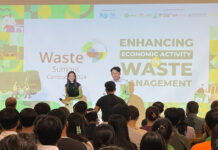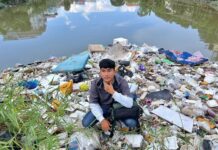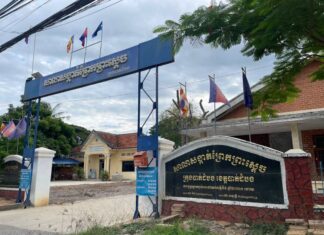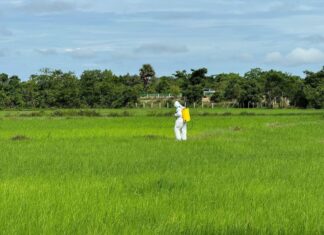By Socheata Hean
Cambodia — In past decades, the family of Heur Sophy, 44, made their living with the flow of the seasons in the northern riverlands of landlocked Stung Treng province.
During the rainy months in the Sesan district village of Kamphun, her father and grandfather would farm the rice fields. In the dry season, they turned to fishing, harvesting much of the family’s annual intake of protein from their nets along the river. From her early memories of life on the water, Sophy could remember her relatives easily filling their boat with night-time fishing excursions from the rich natural fishery.
However, the once-thriving routine of her family and more than 500 other families in Kamphun commune began to change with the construction of the 400-megawatt Lower Sesan II dam, which became operational in December 2018 and altered the river flow and fish habitats. Now, the fishing practices that once sustained entire communities produce only a dwindling, meager catch.
“The water flow has become unpredictable. Fish migration patterns are disrupted, and fish populations have declined,” Sophy said.
Today, Cambodia’s domestic energy mix is largely dominated by hydropower and coal, which respectively account for 46% and 48% of supply. Meanwhile, solar arrays in the sun-drenched kingdom currently provide just about 5% of the country’s electricity.
However, this mix could be dramatically overhauled in the years to come. According to the kingdom’s master plan for energy development, by 2040 a growing use of solar photovoltaic arrays could produce the largest share of electricity on the national grid at nearly 30% of the country’s electricity. This would also come amidst lower investment in hydro or fossil-fuel-fired power.
Even as falling costs and improving efficiency of solar developments have driven up its feasibility, bureaucratic hurdles and political reluctance have historically limited its full potential in Cambodia. If the master plan comes to light, it would mean an about-face from current policy that appears to favor large-scale and often controversial hydroelectric projects.
The environmental tradeoffs of energy infrastructure development are perhaps most easily seen in the riverlands of northern Cambodia, where Sophy and other locals have struggled to adapt to the ecological decline caused by damming.
Near the Sesan II dam, where well-connected development groups are considering new proposals for additional major dam sites, families now make the best of what’s left in the natural fishery.
When Sophy was 15, a one-hour boat trip with her father could yield 80 to 90 kilograms of fish. Now, her family has to travel farther and spend twice as much time, only to catch a third of what they used to.
The same decline applies to their rice harvest during the rainy season. Locals and conservationists say the dams trap vital sediments needed for healthy agriculture around the Mekong River.
When she was young, her family’s rice fields along the Mekong river would yield 3 to 4 tonnes per year. It was more than enough for a “good life,” with extra to trade for profit, she said.
Now, she said, it would be a miracle to get even half of that. The most she can hope for is around half a tonne per year.
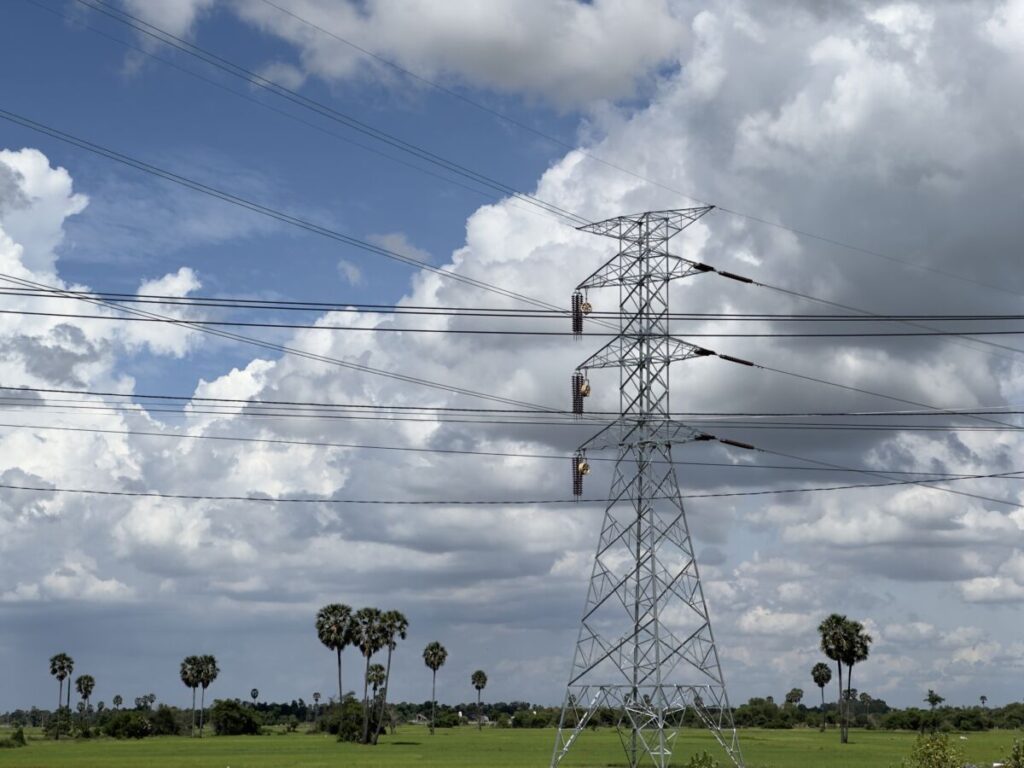
Unharnessed Sunshine
As with most forms of development, energy infrastructure planning depends on cost-benefit analyses.
“The greatest challenge with large infrastructure projects is finding the right balance between the necessary tradeoffs and avoiding overburdening local communities with negative impacts,” said Courtney Weatherby, deputy director and research analyst at the Mekong-focused Stimson Center.
Rapid economic development and continued industrial growth are projected to quadruple electricity demand in Cambodia by 2040, according to the World Bank. This would require approximately $20 billion in investments to expand generation capacity and the transmission grid.
As the kingdom faces the need for these more broadly focused upgrades, Weatherby said it would be a good time to drive toward sustainability.
“Cambodia has an opportunity to push for a greener energy future by requesting investment specifically in clean technologies like solar, battery storage, and closed-loop systems of pumped storage hydropower,” she said.
So far, large-scale solar farm development has moved slowly in light of the country’s immense amount of untapped shine. But that picture may be starting to change.
In 2018, Cambodia introduced a solar generation regulation, a new driver for the country’s solar PV system development. Cambodia’s grid-scale solar development started with just a 10 MW pilot in 2017. Today, nine solar power plants are connected to the national grid and are capable of producing up to 444 megawatts (MW), according to the Stimson Center’s Mekong Infrastructure Tracker.
That tracker also reveals 620 MW of capacity is on the way from two solar farms currently under construction, with an additional four installations planned.
Cambodia is also set to enhance its renewable energy infrastructure with two new storage projects, according to Minister of Mines and Energy Keo Rottanak. Speaking at an August regional ministerial meeting in Jakarta, Rottanak announced the launch of a 2,000 MW battery system next year and a 1,000 MW pumped storage hydro project set for completion by 2028.
This announcement follows Rottanak’s remarks in July, where he highlighted the government’s encouragement of solar energy use, pointing to the reduction of import taxes on solar panels from 35% to zero as a key measure.
Still, experts say more is needed from both hardware and public policy to clear the way for a solar renaissance.
Han Phoumin, senior energy economist for the Economic Research Institute for ASEAN and East Asia (ERIA), said rooftop solar already provides enticing benefits to homes and businesses, especially since the cost of PV modules has dropped dramatically, almost 96% from 2010.
To fully capitalize on that, Phoumin said households should be able to both consume and produce electricity on the grid. That would require EDC to invest in upgrades such as a digitized electricity system with a smart grid to manage weather forecasting and load-demand forecasting, he explained.
“EDC would need a system that can automatically predict every minute in-and-out energy, a stabilized grid to avoid unexpected blackouts and battery storage to store unused power for later supply,” he said.
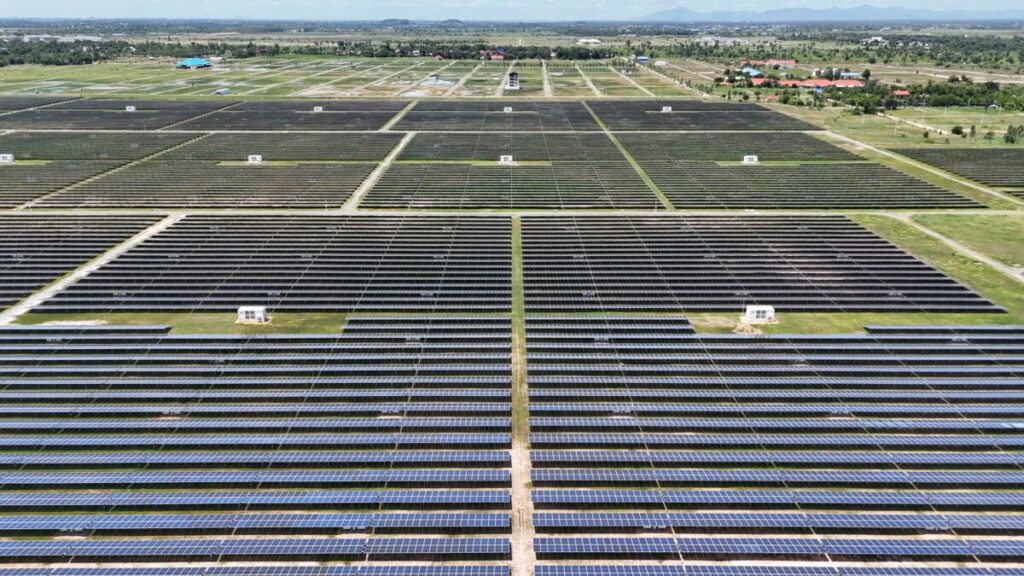
The Solar Push Amidst Industrial Growth and Global Sustainability Demands
With all that sun beating down, the vital garment, footwear and travel goods manufacturing sector may be the country’s best vehicle for change. That’s because producers are increasingly eyeing rooftop solar arrays to cut energy costs while meeting sustainability demands from international brands.
The garment industry plays a significant role in Cambodia’s economic growth and is one of the largest energy consumers. Home to more than 1,300 factories employing about 840,000 workers, most of whom are women, the country’s garment sector contracts with major international fashion brands such as Adidas, Gap, H&M, Marks and Spencer, Nike, Tesco, and UNIQLO.
Transitioning to solar energy could significantly reduce the carbon footprint of Cambodia’s industrial sectors and align with global sustainability goals. This move will not only free Cambodia from a reliance on high-emission energy sources but also meet the growing demand for cleaner production methods from international buyers in the garment sector.
“Our clients are from European countries, and they demand us to operate with clean energy, “ said So Saveth, a general manager of the Footsteps garment factory in Phnom Penh, which has had an on-grid rooftop solar array since 2018. “From a business perspective, we want both financial and environmental feasibility.”
In Cambodia’s garment sector, wood accounts for about 70% of energy consumption, as revealed in the energy audits of 50 factories conducted during the EU Switch Garment project, which aims to boost competitiveness and reduce environmental impact. Around 300,000 tonnes of wood are burned and used by the garment sector each year in the production to produce heat and steam, producing roughly 368,000 tons of carbon emissions into the atmosphere.
The U.N.’s goal to limit global warming to 1.5°C requires a 45% reduction in emissions by 2030 and net zero by 2050. The global garment sector currently accounts for up to 8% of the world’s greenhouse gas emissions, but experts say the industry’s emissions could rise 49% by 2030 if current practices continue.
For industry players, all of these factors plus external pressure make a transition to sustainable production both necessary and unavoidable, said Ken Loo, the secretary general of the Textile, Apparel, Footwear & Travel Goods Association in Cambodia (TAFTAC), formerly known as the Garment Manufacturers Association in Cambodia.
“We encourage our members to install rooftop solar, claiming it is a way to meet buyers’ demand and their commitment toward 100% renewable energy by 2050,” he said.
“If we meet the criteria from buyers, it means the factories could obtain more orders from buyers,” he added. “On the other hand, if we fail to meet buyer’s demand, the factory could lose the orders.”
Along with speaking directly to industry, Loo said TAFTAC also works with the government to push for better energy policy and make it more convenient when factory members want to install rooftop solar.
In July, TAFTAC joined a coalition of business advocacy groups that beseeched the government to cut fees applied to users of large PV systems, most of which are in the industrial sector. The EAC has not yet shown signs of any willingness to ease these restrictions.
Heng Kunleang, the government spokesman for the EAC’s overseeing Department of Energy, did not respond to a request for comment. Officials managing the energy sector have said in the past that the capacity charge – a monthly fee applied by PV project size rather than usage – is necessary to keep the grid stable and funded.
“We are trying to convince the government how important it is to have a policy that makes it easier for our members in the garment sector because it is the demand from our buyers,” said Loo. “If we don’t have that, our buyers could leave us, leave Cambodia. Therefore, we need policies that support our sector for this transformation.”
—
This story was supported by Internews’ Earth Journalism Network through the Strengthening Transparency in Infrastructure Development Through Environmental Reporting in Southeast Asia project.
Socheata Hean is a multimedia journalist in Phnom Penh, Cambodia. Her coverage is mainly on politics, human rights, education, environment, GEDSI, health, cultures, and arts — all of these align with the UN SDGs. These reports have significantly influenced decision-making at various levels, from government bodies to UN agencies and NGOs.




